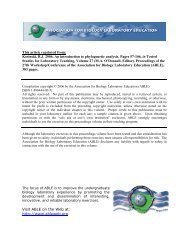A Quantitative Study of Litter and Soil Invertebrates - Association for ...
A Quantitative Study of Litter and Soil Invertebrates - Association for ...
A Quantitative Study of Litter and Soil Invertebrates - Association for ...
Create successful ePaper yourself
Turn your PDF publications into a flip-book with our unique Google optimized e-Paper software.
86<br />
<strong>Litter</strong> <strong>and</strong> <strong>Soil</strong> <strong>Invertebrates</strong><br />
with the frame still unmoved, place a cardboard square, approximately 9 cm × 9 cm, at that<br />
location. Lift the sample upward, while holding the sample in the frame, resting on the cardboard.<br />
Place another cardboard square on the upper surface <strong>of</strong> the sample <strong>and</strong> carefully move the sample<br />
out <strong>of</strong> the frame <strong>and</strong> secure the cardboards in place with two rubber b<strong>and</strong>s, all the while trying to<br />
keep the sample oriented more or less horizontally. Place the sample in a plastic bag <strong>and</strong> tie so the<br />
bag provides some support <strong>for</strong> the now exposed cut sides <strong>of</strong> the sample. If the sample is crumbly<br />
put rubber b<strong>and</strong>s around the outside <strong>of</strong> the bag so as to provide support to the integrity <strong>of</strong> the<br />
sample organization. Now it can be carried in a knapsack or large pocket back to the laboratory.<br />
Care should be taken not to compress the sample or allow desiccation.<br />
To examine, place the sample on a paper towel on the stage <strong>of</strong> a dissecting microscope (Figure<br />
4.3). Add adequate illumination <strong>and</strong> begin at the litter surface. Depending on the assignment <strong>and</strong><br />
in<strong>for</strong>mation which the student has in h<strong>and</strong>, work down through the sample. Observe the<br />
following: changes in color; condition <strong>of</strong> surfaces <strong>of</strong> organic matter (intact <strong>and</strong> skeletonized leaves<br />
<strong>and</strong> fragments); evidence <strong>of</strong> bacterial <strong>and</strong> fungal activity; presence <strong>of</strong> water films <strong>and</strong> dew drops;<br />
kinds, numbers, <strong>and</strong> sizes <strong>of</strong> invertebrates; change in space size <strong>and</strong> configuration with change in<br />
stratum; <strong>and</strong> evidences <strong>of</strong> humification. Try to fill in the gaps as to what has happened over time<br />
to cause the lower, older layers to assume their present condition. Where do s<strong>and</strong> grains appear?<br />
What does this indicate? Have roots invaded any strata <strong>and</strong>, if so, what does this mean?<br />
When the examination is completed the sample will probably be in shreds <strong>and</strong> needs to be<br />
discarded. Care should be taken to protect the microscope from dirt <strong>and</strong> dust. Depending on the<br />
instructions given, invertebrates may or may not have been listed, tallied, <strong>and</strong>/or preserved. I<br />
recommend retrieving representative <strong>for</strong>ms <strong>and</strong> preserving them into 70% alcohol. Among other<br />
things, the student gains some impression <strong>of</strong> behavior <strong>and</strong> reaction to pursuit by the specimens <strong>and</strong><br />
an appreciation <strong>of</strong> the difference in appearance between the living <strong>and</strong> dead condition. This is<br />
helpful when the quantitative sample is closely examined. It allows a better visual comparison<br />
between those <strong>for</strong>ms observed alive <strong>and</strong> those extracted in the funnel. The number <strong>and</strong> kinds seen<br />
in the live 10 cm × 10 cm sample will be conspicuously fewer than one-half those extracted in the<br />
10 cm × 20 cm sample. Why? Why the difference in the number <strong>and</strong> kinds in each sample?<br />
The student is able to demonstrate powers <strong>of</strong> observation <strong>and</strong> knowledge in a final assignment<br />
that may be phrased something like, “Describe what you observed in the live sample.” A more<br />
difficult task might be the construction <strong>of</strong> a detritovore food web or the assignment <strong>of</strong> a<br />
relationship between external morphology <strong>and</strong> role <strong>of</strong> the animal in the habitat.
















